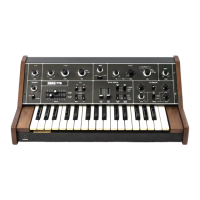mk<nmi¥
•
im
PLAYING
PROCEDURE
AND
METHOD
li x 4
-y
?•
£
Ait
H^'
B
>*£««**¥
LS -Tilt?* ^tfvfftfcif
aasJil-
(Practice playing in
accordance with the following.)
•
Set the rotary knobs, the
slide knobs
and the
lever switches
on the control panel
as shown in
the drawing
below.
•Plug the
power cord
into
socket,
connect the
synthesizer output
and the
amplifier using the
connecting
cord provided, and turn the
power
switch ON.
•Depress
a key, and the
instrument will emit
a
sound
similar
to
that of an
electronic organ.
Then, adjust
sound volume to the
required level.
n'- ^m
a n
."0.
~0
CM
El
©
VCO 1 VCO II
€3
«
J
1
2
S
'N
PORTAMENTO
@
10
8
Sy'IIIK'**" KOflO
I
1
3 I
S
6 7
t
9
10
I
I I I I I I
f
I
I
I
I I I I I
I
.8 8
8
8
ENi/ELOPE OEHEBATOR
8
8
8 8
VCO MOD 5
§
0>-~--<IO
Bf^
gj^
VltJHATO
*
®VCO I
•
PITCH
-
OCTAVE-
MODE
i.&VtltcWh h'-vfoJAj£
fi-^lllLTT?^
rtnmsiiftiz
mt&Ms,
stent
ti&
<
&u
*
w<oo**-c£Kfi*j £1*9281,
7*
*t;
CD
VCO I
•PITCH Turn the PITCH knob clockwise and
counterclockwise, depressing a key.
Turning it clockwise will make in-
crease the
pitch
and
counterclock-
wise
low reduce it.
Adjust the pitch for tuning with
other instruments.
•
OCTAVE-
-Turn
the OCTAVE knob, depressing
a key. It has five
control steps, the
tone varying by one octave for
each.
With its F-scale 32 keys, two and a
half
octaves combined the synthesizer
actually covers
a tone range equi-
valent
to 92 keys, 7 and a half oc-
taves.
•
MODE Turn the MODE knob and the OC-
TAVE
knob
simultaneously while
playing
a simple melody. You
will
then
learn the
characteristic of
each
wave
form.
-
5
-

